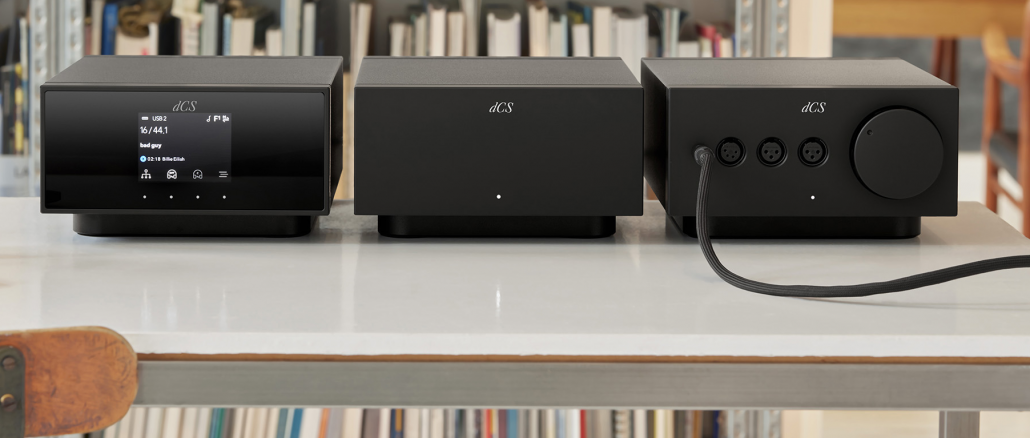
The DCS Lina Master Clock Review w/ Lina DAC
By Steve Huff
If you have noticed, I recently reviewed the $12,700.00 high end DCS Lina DAC and you can see that review HERE as it’s mandatory to read that before this one if you are interested in the set.
I reviewed the Lina Network DAC all in its own within my two channel speaker system but at the time I assumed it could be bettered still via the Master Clock DCS has created just for the Lina Network DAC.
When I bought the Lina DAC I could not afford to splurge on the clock since I just splurged for the DAC. Even so I figured I would be able to try it out sometime down the road. Well, lucky me! It seems I did not have to wait too long.
About a week or two after the review of the Lina DAC went up I received an email from DCS asking if I wanted to try out their Master Clock for the Lina. I’d be able to evaluate it for a while to see exactly what it brings to my system. I was also sent some beautiful (and pricey) cables from Shunyata. The Alpha and Omega Clock 75 cables. I would be able to compare the cheap generic stock cables to some pretty pricey hand made cables. Hmmm, call me skeptical as the Omega’s are $3k EACH, meaning a set of them will get close to the cost of the clock itself.
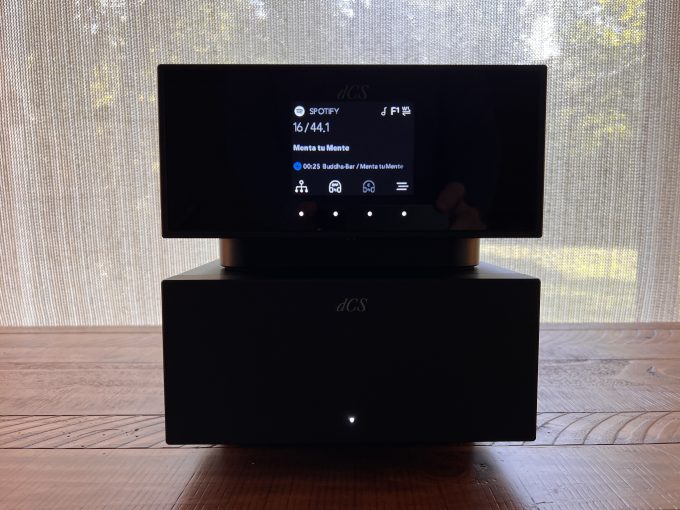
But hey, this is going to be fun.
What an awesome thing to see in my inbox as truth be told I have been VERY curious about this clock and wether it will bring a real tangible improvement to the music. The clock clocks in at just over $7,000 so it is not something I would take lightly. This Lina system was created by DCS to be an end game Headphone setup. The Amp, the DAC and the Clock all add up to make one heck of a system for headphones. As in, as good as it gets.
While the Lina AMP is surely made only for headphones, the DAC and clock can be used within a two channel system just like any other DAC. The Lina DAC was my personal fave over all I have auditioned over the last couple of years, and I have heard many including those from Nagra, Chord, and Weiss. Even so, I am not one who says you need to have a $10k and up DAC to appreciate music because you certainly do not, but there are differences between DACs at this level. The key word is “differences” rather than “best” as I do not see any HiFi piece as “the best” as what is best for one person is not always best for another.
Audio is very personal.
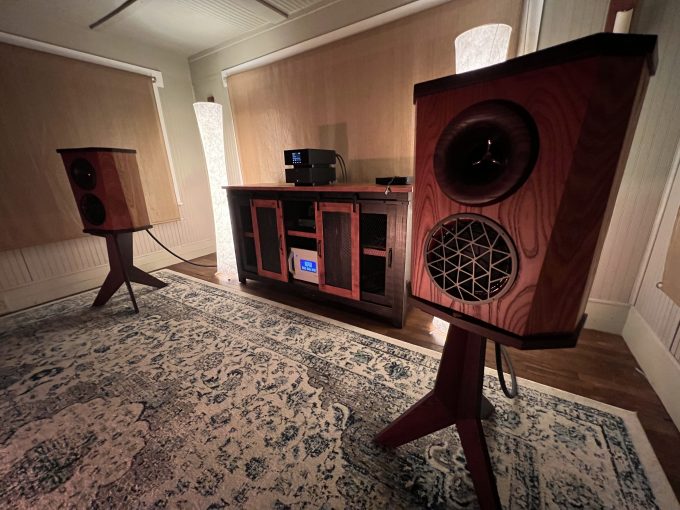
AS FOR THE CLOCK
I have only reviewed one other piece of gear with a master clock inside of it and that was the Innuos Phoenix as I added it to an Innuos Zen streamer at that time during my review. It did and without question improve the sonics but not in the way we usually think of when it comes to audio improvements. That Phoenix made the sound more fluid, smooth, refined and well, more expansive. There were more delicate details emerging and the music was even more beautiful with that Phoenix added.
I WAS EXCITED TO GIVE THE Lina Clock A TRY
With the Lina DAC installed and being enjoyed every day here I patiently waited for the Lina Clock to arrive.
While I was waiting for that big Fed Ex to drive up our driveway with the clock I happily let the Lina DAC perform digital streaming duties within my system, and I was loving every minute of it.
I have a few DACs here now but the fun in this is that I will be able to compare them to future pieces for you guys.
As it is now I believe the Lina DAC allows my system to be the best it can possibly be at this moment. I would need a speaker and amp upgrade to get better (and that’s not happening as I love my speakers and amps).
So waiting for the clock to see what changes would come brought on some strong curiosity. Would it actually improve the sound or make it worse? Sure, sometimes what we have is great and adding to it changes it in a way we may not like as well. As I sat listening and writing I heard the dogs bark and go nuts, as they usually do when someone is headed up the drive. I looked out the window and saw that the Fed Ex truck was speeding down the driveway. The clock arrived!
There it was, in the same size box as the Lina DAC (all pieces in the Lina range are the same size and same enclosure).
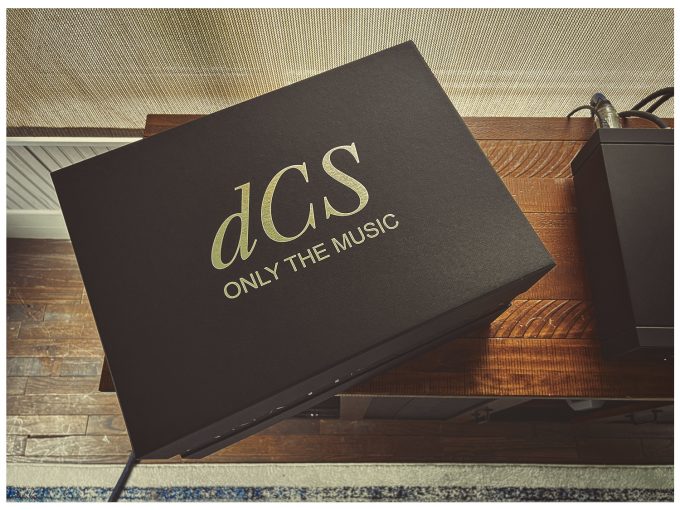
After a few moments I opened it up and placed it within the system, hooking up the two basic and generic cables that it came with to connect it to the DAC. I will also be testing it with a couple of Shunyata cables later on in this review to see if cables make a difference with the clock as well.
One thing to note is that this master clock will only work when using the Lina DAC in the Network or USB setting. If we use one of the other inputs, the clock will not make any improvement. This means I will be using the Network option to test the Master Clock as I am using the Lina DAC as my streamer as well. The streamer inside of the Lina DAC did indeed best my long term Lumin U1 Mini for streaming duties and it’s nice to have an all in one of this caliber.
When installing the clock I had to remember to set the Lina DAC to “AUTO” mode as instructed by John Giolas from DCS.
Here is what he told me “World Clock Auto is the correct setting for us with the Lina Clock. The Master Clock setting in the Lina allows the Lina DAC Clock to be used as the master clock. When everything is set up and connected correctly, you’ll notice the icon on the DAC will read W1 for 44.1kHz-based signals (and the multiples) and W2 for 48kHz-based signals (and the multiples). I.e., with a 24/96 streamed signal from Tidal or Qobuz, for example, the icon would read W2”.
When I placed it in my system I let it run for a few days and left it on 24/7. After it had some time to warm up I settled in for a long listening session on a beautiful quiet late summer night.
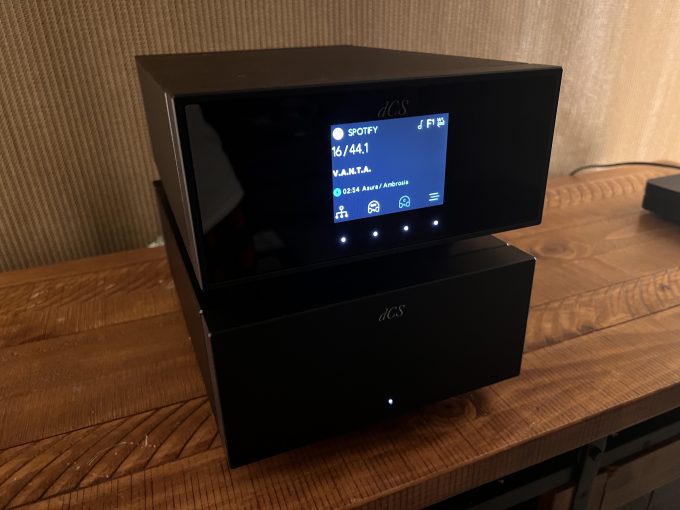
I fired up some familiar music from both Tidal, Qobuz and even Spotify. The music sounded as beautiful as always as the Lina DAC is a great synergistic match in my system, so I already am over the moon with how everything sounds.
Just with the Lina DAC on its own, the music has scale, dynamics, a smoothness that is sublime, and bass for days. DCS is among the very high end realm when it comes to DACs and clocks. They have been at it for over 35 years but this Lina DAC is the least expensive DAC in the lineup. The other options from DCS such as the Rossini and Vivaldi are into the stratosphere when it comes to price, but they sure are something to dream about. The Lina sounds so good I can only imagine what those would sound like.
Was placing in the Clock an INSTANT WOW MOMENT?
I was sitting and I thought for sure the music was improved but it was hard for me to put my finger on what it was doing (at first). I thought I was hearing a more detailed or clearer presentation. It was as if the music became more clear and details were more easily heard, maybe even more pronounced by a teeny bit. I also thought I noticed a more 3 dimensional presence and the music just seemed to sound absolutely stunning no matter what I played. I also heard more of the in studio or venue reverb making itself known.
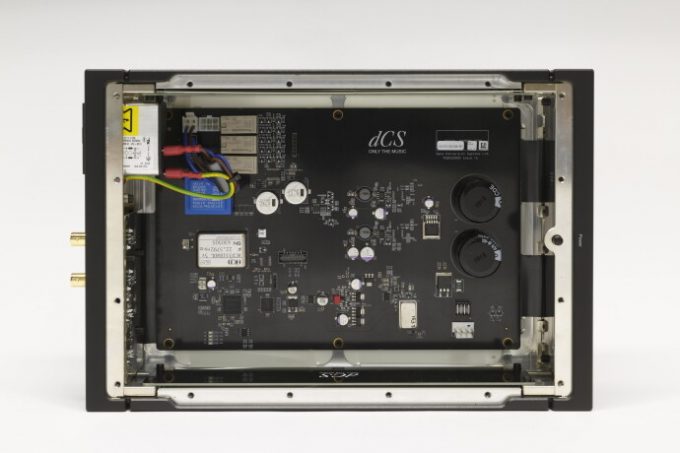
But I wasn’t sure yet if it was worthy of the price tag.
I kept the clock in and running with the DAC and after one week I decided to take out the clock. Keep in mind, before this moment I did not switch it in and out on the fly as I knew something like this takes time to appreciate. If I noticed it instantly when it was taken out I would then know it was having a positive impact. Most audio gear really proves what it is made of when you remove it from your system, not so much as when you add it.
When the Clock was taken out of the system and I went back to just the DAC the sound was indeed different.
With the Master Clock out of the system the sound became a shade darker and I felt as if the small little details I was hearing all week were less prevalent, the imaging was rather amazing but not as precise and the soundstage was a touch smaller, though not by much. There seemed to be more clarity, and more silence in the background as well. It had more life to it and for me it was a noticeable change and improvement, easy to hear. Details emerged in a more precise way with the clock enabled, and there was a cohesive coming together of the music. It did indeed take the DAC to a new level but let’s be real here…
THIS IS A NEARLY $20,000 COMBO so basically the clock turns the Lina Network DAC in to a complete high end world class DAC option. Is the sound worth $20k? Well, that is what my bucket list speakers cost (Fleetwood Deville SQ) and I remember many years ago so many thought that a DAC did little to change the sound (let alone a master clock) so this was a giant leap for me into uncharted territory. It’s the first $20k+ digital front end I have ever tested out.
For me the combo of the clock and DAC was absolutely without question hands down the best I have heard digital ever sound in my life, let alone in my system. Why should I have expected less? It’s DCS and while not everyone will love their flavor of sound, it is quite beautiful. So refined and airy with the clock installed. So clear and transparent yet still with a very nice solid bass performance.
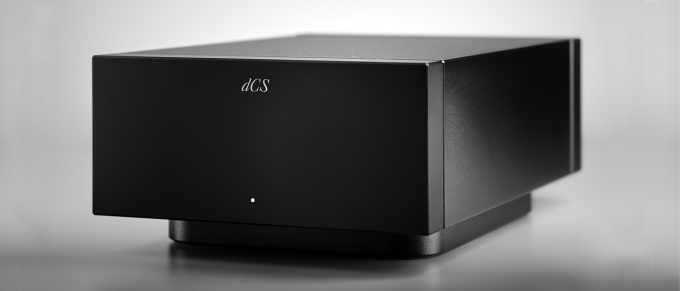
I can not and will not proclaim to have heard every system but I have heard many of them up into the stratosphere. My system with the Lina stack installed is sounding magical.
For me I always look at performance first, build second, name third and price last. Being DCS we know this DAC is for those of us who are picky about our music reproduction and for those who have the cash to acquire something that is at this level. DCS is known as one of the finest brands in audio and for most of us, a dream product. They have been a dream product for me over the last 23+ years. It took me that long to own a DCS DAC and even so, I had to go with the entry level DAC.
I have to ask myself if $20k is worth hearing the best digital reproduction I have ever heard within my own system. For me, it may be as I already invested in the Lina DAC and the $7k clock does take it up to the next level. It’s something I will have to think about when I have the extra cash down the road but yes, for me the sound of this combo is heavenly and superior to all others I have heard (though I have not heard any DAC above this $20k price point) to date.
I am sure many of you were hoping I would say “Oh, it didn’t make much difference at all” but my system is very revealing and shows differences in gear and cables very easily. It’s a reference system I use to evaluate products for review, so it has to be.
With 3 weeks under my belt with the Clock I easily hear what it is doing, and it does indeed improve the DAC. It’s not hard to hear what it is doing in my system.
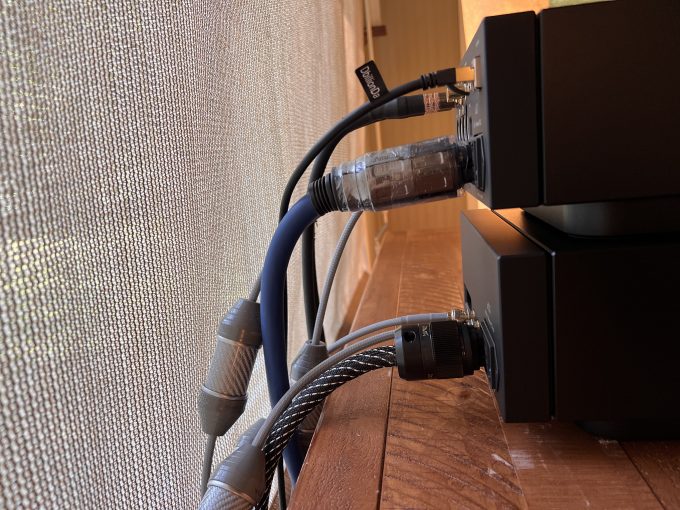
WHAT A MASTER CLOCK DOES ACCORDING TO DCS
Our Grade 1 Master Clock uses dual crystal oscillators to deliver a precise and stable clocking reference. Used as part of a complete Lina system, it enhances all aspects of sound for an even more immersive listening experience
- Allows the Lina Network DAC to be locked to a master reference signal for enhanced audio performance
- Minimises jitter and irregularities that can cause distortion
It is interesting that they mentioned the sound would be more immersive with the clock, as it really truly is. In fact, that is what I notice the most.
IN AND OUT
So after 2 more weeks of having the clock in I take it out from the system simply by turning it off.
I spent the next 3 days listening again without the clock, and getting used to the presentation. I even made a playlist of 15 songs that I listened to every day, same songs again and again.
I then placed the clock back in and there it was, a super easy to hear difference within my system.
Again, there was more air, and an extra layer of refinement. No hint of digital being the source of the music and it seemed as if the music had an ease and flow as if it was just flowing through unclogged arteries (cables) into the heart of the system (the speakers). Spotify sounded amazing and equally as good as Qobuz, and I preferred it to Tidal. This really improved the quality of Spotify which told me Hugh res music was not needed in this system. It all sounded fantastic.
With the clock out I noticed a very slight hint of dullness, but the Lina is NOT dull at all! I noticed this only after comparing it with and without the clock. You would never notice this without a comparison or living with the clock installed for a few weeks. There is a reason many DCS fans rave about their master clocks. They do improve the sound, presentation, air, reverb, and flow.
The clock added a touch of expansiveness to the sound, and everything was cohesive and correct. It was sublime.
I have heard many a beautiful system and I have had gear in here that has been heavenly. There are very few “bad” products in this upper end of the HiFi Realm and it comes down to synergy, preference and budget.
The Shunyata Alpha Clock 75 Cables are an amazing Match for the DCS and offer up much of what the triple the cost Omegas do. They are a vast improvement over the stock cables
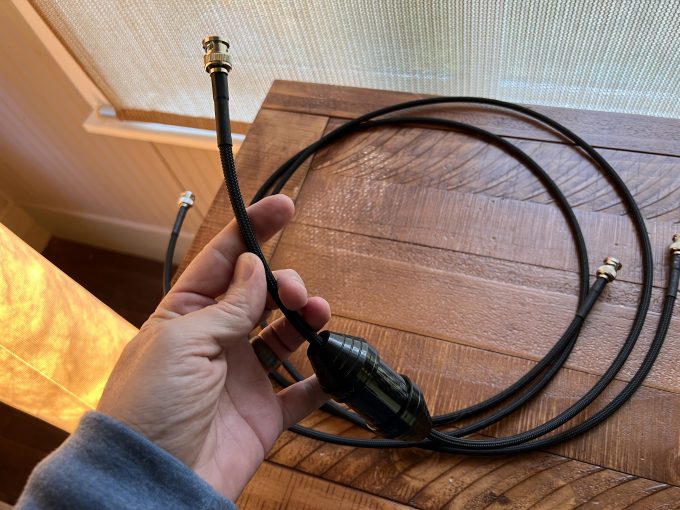
TRYING SOME HIGH END CLOCK CABLES
In the box of the Lina Clock DCS includes two generic cables to connect the clock to the DAC. They looked similar to what Chord includes with the M Scaler. Generic, which is one thing I can say is a shame as the cables I were about to audition really upped the game even further.I understand to some extent why high end audio companies include only generic cables in the box. It is because those who buy this kind of product will almost always experiment with cables they like or have a preference for.
I admit, I was not even aware a set of clock cables existed that come in at $3k a piece (you will need two for the DCS). One would assume “digital is digital”…”It’s all 1’s and 0’s”. Well, that may be so but there is something happening here that is hard for me to understand.
I really do not know how it works or why but it does.
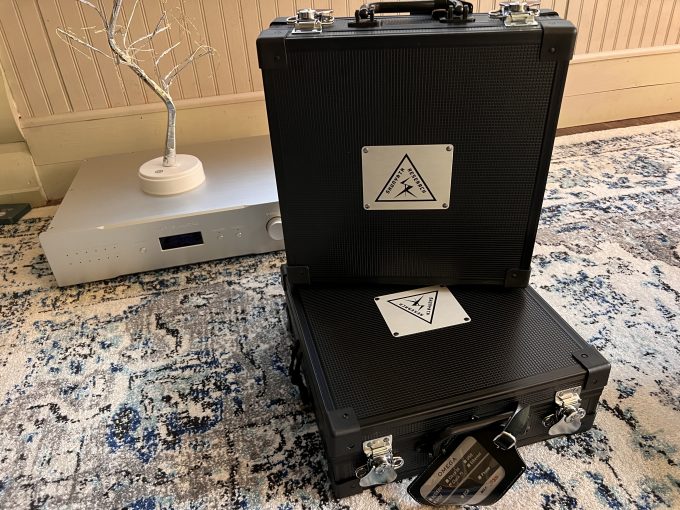
You guys know I do not do technical reviews or talk science. For me, it’s about the sound and emotion.
Shunyata sent me two sets of cables. One set was the Alpha Clock 75 Cables which come in for $1k a piece. So a set for the Lina would set you back $2k. They also sent me, in two black metal suitcase style cases, also wrapped in a velvet kind of material, the OMEGA Clock 75 Cables. These are $6k for a pair. Phew. Hard to fathom for me but I was excited to try. If these cables failed to impress I would tell you as I have no financial ties to any audio company (see any audio ads here)?
I started with the Omega because I had to hear what $6k worth of Clock cables would do.
What?!?!?!
Yes, I was immediately impressed and even more so after a week but even so, not everyone would like what these do. With the Omegas in the sound was a teeny bit more tipped up in the treble, even more airy and brought my Deville’s treble to a level I did not know they could reach. These cables were 100% doing something, and they did create a bit of a larger stage as well. The Lina DAC went from smooth and a touch warm to complete audiophile territory with the clock and Omega cables. There was still warmth but it was more of a warmth with added clarity. These cables were truly letting the dac and clock shine, but my oh my are they pricey.
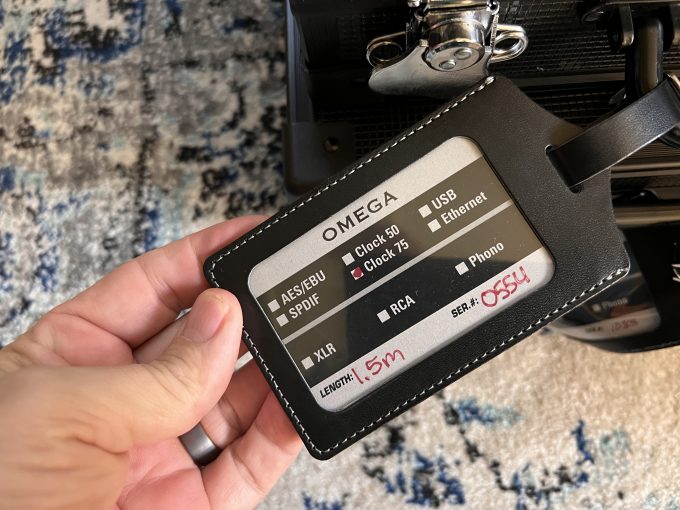
Shunyata OMEGA Clock 75 Notes
When I swapped the generic cables for the Omega cables this is what happened:
- The sound was quite a bit more crisp, even more realistic. The voice…if I thought I heard every detail in the voices before, well, I still did but these voices now sounded so sweet, so realistic. An improvement for these ears.
- The sound was coming out of blackness before but now it was like a big black hole in space appeared in my room and sound was just emitting from total and complete blackness.
- I heard things in song I never heard before (I know, cliché) but this is legit. Every little sound was there with extra life but it was still full, beautiful and sounded even better than what we may hear in a studio.
- With these cables it elevated the quality by about 10%, maybe 15%. That is a lot when we talk of diminishing returns. These are beautiful cables, I just wish I could afford them.
- Bass had zero mud. Tight as can be. Every guitar strum…I heard every string in detail but with real life behind it. Reverb trails hung in the air more withe the Omega cables installed.
So that is what $6k for two cables brought to my system, and yes, cables make a difference. They do if you have a system that can show it, a system that is set up right, in a dedicated room and with gear that works well together. I know many do not believe in cables and that is ok. I wish I did not hear these differences, but I certainly did. It was not hard to notice.
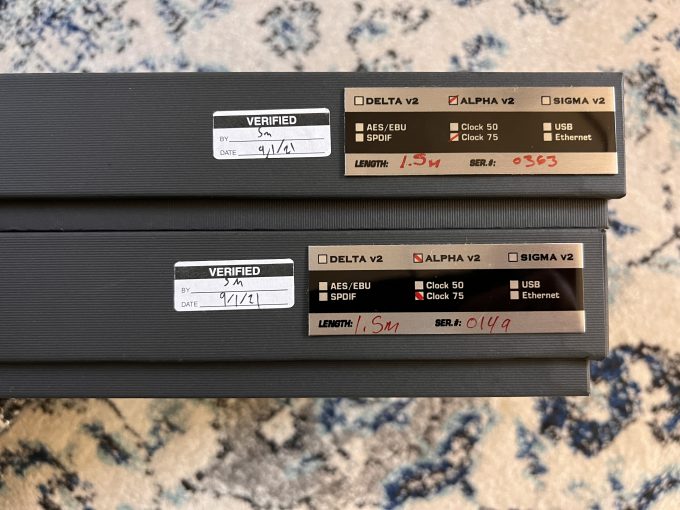
Shunyata ALPHA Clock 75 Notes
When I took out the OMEGA’s and replaced them with the lower cost ALPHA cables I had some thoughts:
- Compared to the OMEGA these had similar traits but less of them. Think of it as a scaled down OMEGA but a touch warmer and a touch thicker.
- VS Generic Stock, a better flow to the music, more prevalent details and just more life. The stock cables have a smooth sound, a sound that is a little bit darker than the Shunyatas but the Alpha and Omega bring a life to the setup that makes it perfect for neutral to warm speakers. If you have brighter speakers the Alpha would be my pick. Warm, Omega can liven them up.
- If you do not want to part with cash for these cables, both the Alpha and Omega, do not audition them. If you do, you will want them. They have a way of “finishing off” the sound. I know it is very hard to swallow what these cables cost but they do make changes, and it’s no different than buying a new DAC, AMP or Speakers. With amps and electronics we feel like we are getting more for our money. A cable is just a cable right? Wires. Again, not sure how these make changes to the sound but they do. I always recommend an audition first before buying any audio product. Do not take my word for it, this is something you have to hear for yourself.
Keep in mind, the Lina DAC is $12k. The Clock is $7k. The Omegas are $6k. So that comes out to $25,000 for a Streaming DAC setup fully decked out. Phew. I never in life thought I would be able to hear something of the caliber in my home. This stack makes my $15k turntable setup sound broken. I am sorry but it does. There is much more life to my digital than my Analog and it sounds better in every way. I would probably have to spend double of what the Lina stack cost on an analog setup to equal it.
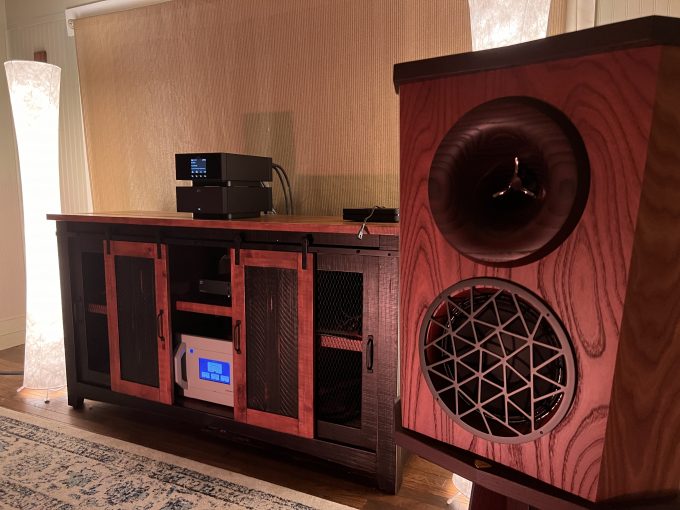
For anyone who has the funds and you want some of the finest sounds you can achieve for digital, take a big long look at DCS. The Lina DAC is just the start. You can later add the clock and gain improvement. You can then later add cables, any cables, as the stock clock cables are not the best.
You can even spend much less on cables and get a jump in sound quality but man, these Shunyata cables are sweet.
If you do not believe in cables, then good for you. It means you will never go down that rabbit hole and I am jealous : ) Really.
As for the clock, yes indeed it made a difference. It brought that extra level of refinement, air, soundstage, impact and even details emerged ever so sweetly that I didn’t notice as much as before. It really came into focus with the Shunyata cables. It seems this audio rabbit hole is never-ending.
This is the best I have ever heard digital sound in my system in over 35 years of HiFi.
You can see more on the DCS Lina Clock HERE
You can read more on the Shunyata Cables HERE and HERE
You can buy the Shunyata Alpha Clock 75 from my good friend Dan at Dedicated Audio (I make no commission or kickbacks and he runs a great HiFi shop I use to be a regular at, just showing him some love)!

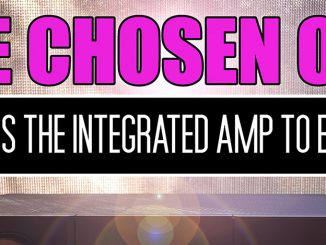
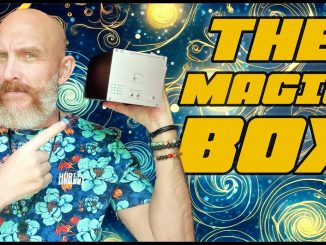

I recently had a DCS Bartok Apex to try at home, but as an aside, my dealer also lent me a Denali/Alpha XC combo. Prior to returning them, I first took out Denali… oh my goodness how dull and uninvolving the Bartok sounded without it.
My advise to anybody is borrow a Shunyata Denali and remember it improves EVERY component in your system. I’m currently auditioning Altaira, with the intention of completing my mains/grounding end point.
Great review of the DCS Lina and Clock. Pretty expensive but I feel that the DAC is probably the most critical part of any system. I currently have a Denafrips Terminator II with Denafrips Hermes DDC clock linked with I2s cable. The Terminator II and Hermes DDC may not compare with the DCS Lina but are excellent for about 30% of the cost of the Lina combo. I’ve tried the Terminator II without the Hermes DDC and found similar changes to the sound that you reference in your review, soundstage shrinks slightly and details are obscured slightly without the Hermes. Hopefully, you’ll be reviewing the new Terminator Plus 12th Anniversary Edition with a Hermes or Gaia clock linked in the new future. It would be interesting to see just how far off the Denafrips equipment is. Thanks.
Another interesting review – thanks. I now have a system that sounds very good and good enough for me. I really don’t crave better. I have spent a lot of money which is ok but I really do not want to spend more given that listening to music is something I don’t do every day. It is important but not the only thing. I have found that the more I listen carefully to the music, the less I pay attention to the system.